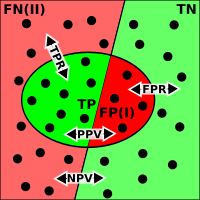Evaluation of binary classifiers

Alright kiddo, so imagine you have a toy box full of different toys. Now, I’m going to ask you to sort these toys based on whether they are your favorites or not your favorites. This is kind of like how we ask computer programs called classifiers to tell us if something is good or bad.
Now let’s say you pick out a toy and you say it’s your favorite. But, when I ask you why it’s your favorite, you can’t really explain it. That’s okay, sometimes we might like things just because they feel good or look nice.
This is similar to how we evaluate binary classifiers. We give them a bunch of examples, or toys, and we ask the classifier to tell us if each toy is good or bad, and then we check to see how well it did.
For example, let’s say we want the classifier to tell us if an animal is a dog or a cat. We give it pictures of dogs and cats and the classifier tells us which one it is, dog or cat. Now, we check to see how well the classifier did. Did it correctly identify most of the dogs and cats or did it make a lot of mistakes?
We have different ways to evaluate how well a classifier is doing. One way is by using something called accuracy. This is like counting how many times you got the toys sorted into the right boxes.
Another way is something called precision and recall. This is like trying to pick up all of your toys that are blue and putting them in a blue box. If you pick up only blue toys and put them in the box, that’s precision. If you pick up all of the blue toys, that’s recall.
Finally, there’s something called F1 score which combines both precision and recall. This is like when your mom and dad make a cake together, it takes a little bit of both of their help to make it perfect.
So in summary, evaluating binary classifiers is kind of like sorting toys into different boxes or trying to figure out if an animal is a dog or a cat. We check how well the classifier did by using accuracy, precision and recall, and the F1 score.
Now let’s say you pick out a toy and you say it’s your favorite. But, when I ask you why it’s your favorite, you can’t really explain it. That’s okay, sometimes we might like things just because they feel good or look nice.
This is similar to how we evaluate binary classifiers. We give them a bunch of examples, or toys, and we ask the classifier to tell us if each toy is good or bad, and then we check to see how well it did.
For example, let’s say we want the classifier to tell us if an animal is a dog or a cat. We give it pictures of dogs and cats and the classifier tells us which one it is, dog or cat. Now, we check to see how well the classifier did. Did it correctly identify most of the dogs and cats or did it make a lot of mistakes?
We have different ways to evaluate how well a classifier is doing. One way is by using something called accuracy. This is like counting how many times you got the toys sorted into the right boxes.
Another way is something called precision and recall. This is like trying to pick up all of your toys that are blue and putting them in a blue box. If you pick up only blue toys and put them in the box, that’s precision. If you pick up all of the blue toys, that’s recall.
Finally, there’s something called F1 score which combines both precision and recall. This is like when your mom and dad make a cake together, it takes a little bit of both of their help to make it perfect.
So in summary, evaluating binary classifiers is kind of like sorting toys into different boxes or trying to figure out if an animal is a dog or a cat. We check how well the classifier did by using accuracy, precision and recall, and the F1 score.
Related topics others have asked about:
